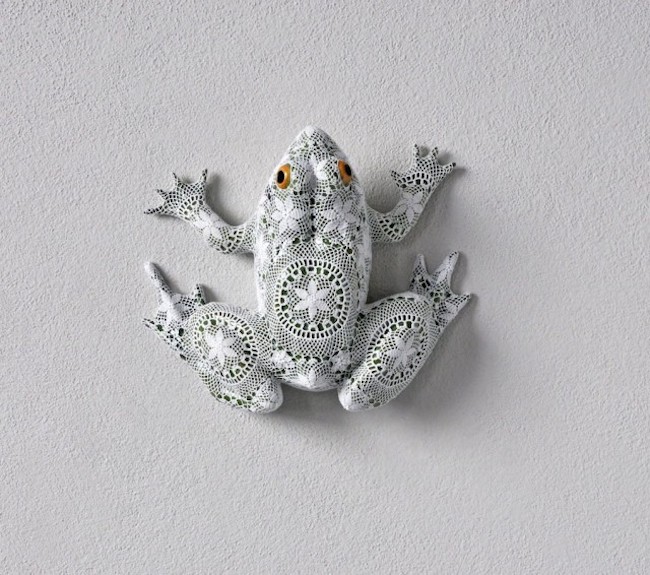Paris-born artist Joana Vasconcelos has been exhibiting her work since the mid-1990s. Today she lives and works in Lisbon, Portugal and has had solo exhibitions in Paris, Denmark, Spain, Portugal and the United Kingdom.

The artist describes her work as toying with and appropriating pre-existing objects and realities. She states:
“The nature of Joana Vasconcelos’ creative process is based on the appropriation, decontextualisation and subversion of pre-existent objects and everyday realities. Sculptures and installations, which are revealing of an acute sense of scale and mastery of colour, as well as the recourse to performances and video or photographic records, all combine in the materialization of concepts which challenge the pre-arranged routines of the quotidian. Starting out from ingenious operations of displacement, a reminiscence of the ready-made and the grammars of Nouveau Réalisme and pop, the artist offers us a complicit vision, but one which is at the same time critical of contemporary society and the several features which serve the enunciations of collective identity, especially those that concern the status of women, class distinction or national identity. From this process there derives a speech which is attentive to contemporary idiosyncrasies, where the dichotomies of hand-crafted/industrial, private/public, tradition/modernity and popular culture/erudite culture are imbued with affinities that are apt to renovate the usual fluxes of signification which are characteristic of contemporaneity.”

One of the artist’s projects involves altering ceramic animals and insects by stitching crocheting a “skin” of cotton around them. The pieces come from a faience set designed by Portuguese artist Rafael Bordalo Pinheiro (1846 to 1905). She states of the work:
“The appropriation carried out by Joana Vasconcelos, in the scope of Bordalo Pinheiro’s vast production in ceramics, only includes the naturalist representation of animals – some of them rendered oversize – whose proximity to Man might generate discomfort, awe or fear. Wasps; lizards and snakes; crabs and lobsters; frogs; bull-heads; donkey-heads and horse-heads; wolves; or even cats with an aggressive posture are ambiguously imprisoned/protected by a second-skin in crochet-work, producing a discourse apt to renovate the fluxes of signification associated with the usual relationships between popular culture/erudite culture and tradition/modernity. The use of crochet in a paradoxical imprisonment/protection of the animals, thus relegated to the domestic context, opens up a vast and rich field of interpretation released by the beauty and strangeness generated by the result of the operation.”
Any thoughts about this post? Share yours in the comment box below.



Works by Joana Vasconcelos. Photographs courtesy of the artist.

Ah yes, nicely put, evreeony.
I love Joana Vasconcelos’s ceramic animals covered in crochet. Maybe 6-7 years ago I saw a presentation at Lawrence University where a former Gorilla Girl covered an army tank in Easter Europe in crochet. I crochet–one of the tools in my arsenal. Most of my work in the past 3 years has been paying homage to human/ceramic history using the medium of textiles (multiple techniques). Ann Nathan Gallery who occasionally represents me in Chicago has told me the two hardest things to sell are ceramics and textiles and here you are doing both. Thank you for introducing me to a kindred spirit.